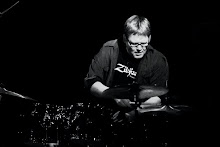Hi folks,
I was checking out Vancouver drummer Jesse Cahill's excellent blog and I was very impressed with his thought provoking post on rudiments, In Defence of Rudimental Drumming . I'm going to share some of my ideas on the subject and although it may seem that my opinions on the subject differ from Jesse's, rest assured I also feel that most drummers do not fully exploit the language found in rudiments.
Now as far as I see it, there aren't many BASIC ways to strike a drum.
There's:
-Single Strokes
-Double Strokes
-Flams
-Buzzes
-Dead Strokes (pushing the stick into the drumhead)
I really see the listed rudiments (when I started there was 26, up from 13, and now I think are 40) as licks based on any combination of these basic ways to make sound with two sticks and a drum. What's a paradiddle? A single and a double, followed by a single and a double starting with the opposite hand. What's a ruff? A double and a stroke or ( the classical way) a buzz and a stroke.
So.....
I'm not saying you shouldn't work on the standard rudiments. In fact we should all be able to play the crap out of them (like Jesse) and then work onwards to create our own hybrid rudiments.
For example, you could play paradiddles but buzz the first note of each set of 4.
I think part of the idea with applying rudiments to the drumset is:
a) personalizing the language.
b) Taking some of the symmetry out of them to create patterns that better fit with modern music.
I know originally this stuff came from marching music, and it's also designed to build hand strength but once we learn some of these patterns it's good to either put them in another rhythmic grid ( 8th patterns to triplets or vice versa) or to either add or subtract a note to make them not divisible by 4 or 8. This will make them more applicable to the open phrasing used in a lot of jazz, fusion, progressive rock, etc.
c) Voicing them on the drum set in whatever way appeals to us.
d) Fully exploring dead strokes and buzzes. It's interesting that, because most of the rudimental literature comes from marching players, these two important and valid drum textures don't get their due.
I'm going to get into greater detail around this stuff in future posts but one great way of using some of this language is to take any exercise from "Stick Control" and do the normal stickings but play them in an odd grouping, like quintuplets or septuplets. Make sure you do this with a metronome. So if you're playing 1 quintuplet for every 2 quarter notes and you're playing doubles the first measure would be this (remember in this case there will 10 strokes, or two sets of quintuplets).
RR LL RR LL RR then the sticking will reverse...
LL RR LL RR LL. To really hear the off kilter effect this creates, put each hand on a different drum. The reason this (and any other normal sticking) starts to sound so weird is that even though the notes don't go over the barline (two sets of quintuplets per bar) the sticking does go unresolved..
Phew! Anyway, I hope that's clear. This will definitely be another exercise I will return to when I have video capability.
In the meantime, practice those 13....or 26..... or 40..........
Monday, November 1, 2010
Subscribe to:
Post Comments (Atom)

No comments:
Post a Comment